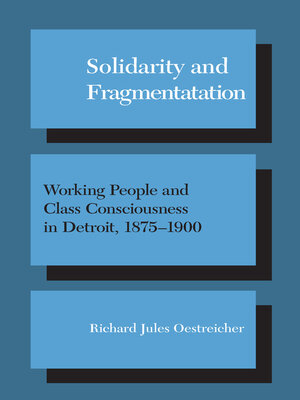Solidarity and Fragmentation
ebook ∣ Working People and Class Consciousness in Detroit, 1875-1900 · Working Class in American History
By Richard Jules Oestreicher

Sign up to save your library
With an OverDrive account, you can save your favorite libraries for at-a-glance information about availability. Find out more about OverDrive accounts.
Find this title in Libby, the library reading app by OverDrive.



Search for a digital library with this title
Title found at these libraries:
| Library Name | Distance |
|---|---|
| Loading... |
How did the interplay between class and ethnicity play out within the working class during the Gilded Age? Richard Jules Oestreicher illuminates the immigrant communities, radical politics, worker-employer relationships, and the multiple meanings of workers' affiliations in Detroit at the end of the nineteenth century.|
Cover
Title
Copyright
Contents
List of Tables and Figures
Acknowledgments
Introduction
1. Living and Working in Detroit
Varying Industrial Experiences
Table 2. Firm Size and Distribution of Factory Employees in Detroit, 1896
Table 3. Class Composition of Detroit Work Force, 1890
Table 4. Detroit Women Wage Workers, 1892: Age at which They Began Work
Table 5. Age of Women Workers in Detroit, 1892
Table 6. Daily Wages of Detroit Workers, 1884
What Did Workers Have in Common?
2. Class Solidarity and Competing Cultural Systems
Detroit's Workers: Who Were They?
Table 7. Occupational Composition of Detroit Ethnic Groups, 1880-1900
Competing Cultural Systems
The Working Class Subculture of Opposition
Craft Unions in the Late 1870's
Labadie, Grenell, and American Socialism
Socialist Activities
Beyond the SLP: The Knights of Labor
Unions
Knights of Labor
Political Action
Table 8. Independent Labor Vote, State Representative Candidates, 1882-1886
The Subculture of Opposition
5. A Summer of Possibilities: May Day of Labor Day, 1886
Factional Divisions within the Labor Movement
The Collapse of the Independent Labor Party
Widening the Breach: The Knights, The Cigarmakers, and the Trade Unions
Powderly, Haymarket, and the Destruction of the Knights of Labor
"Will the butter come?"
Class Solidarity and Working-Class Culture
Political Alliances
Detroit's Labor Movement in the 1890's: The Triumph of Pure and Simple Unionism
Figure 1: Union Membership in Detroit, 1800-1906
Figure 2. Union Membership as Percentage of Work Force, Detroit, 1880-1906
Conclusion
Figure 3. Percentage of Unionization of Nonagricultural Employees, 1886-1929
Note on Source
Index
Back cover
|"Radical history at its best, speaking directly to the descendants of radicals and social visionaries about the lessons of their past."—Monthly Review
"This is a first-rate study of the interplay between class and ethnicity in a late nineteenth-century industrial city. . . . an important book that should be read not only by students of labor and immigration history but by all those interested in the evolution of American culture and values."—American Studies
|Richard Jules Oestreicher is a professor emeritus of history at the University of Pittsburgh.
"This is a first-rate study of the interplay between class and ethnicity in a late nineteenth-century industrial city. . . . an important book that should be read not only by students of labor and immigration history but by all those interested in the evolution of American culture and values."—American Studies
|Richard Jules Oestreicher is a professor emeritus of history at the University of Pittsburgh.







